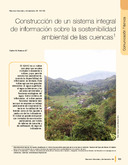| dc.contributor.author | Fonseca Z., C.H. | |
| dc.date.accessioned | 2015-03-19T21:10:27Z | |
| dc.date.available | 2015-03-19T21:10:27Z | |
| dc.date.issued | 2009-12 | |
| dc.identifier.issn | 1659-1216 | es_EN |
| dc.identifier.uri | https://repositorio.catie.ac.cr/handle/11554/5956 | |
| dc.identifier.uri | 475063 | es_ES |
| dc.description | 7 páginas, 3 tabulaciones, 12 referencias. | es_ES |
| dc.description.abstract | Se propone la construcción de un índice integral (ISAAC: índice de sostenibilidad ambiental del agua en la cuenca),que recoge todos los aspectos de calidad y cantidad de aguas superficiales y subterráneas, en sus dimensiones de Estado-Presión-Respuesta y de los servicios ambientales y calidad de los ecosistemas asociados a la cuenca, así como la tendencia frente al cambio climático. El sistema propuesto se exhibe como una matriz o “tablero de seguimiento” que permite leerse horizontal o verticalmente, para establecer índices parciales tanto para las aguas superficiales o subterráneas, como de calidad, cantidad, presión, estado, respuesta. Una prueba inicial del ISAAC se hizo en la cuenca Lerma-Chapala, México, donde la cuenca alta, media y baja mostraron valores de 0,49, 0,38 y 0,27 respectivamente (1,0 sería muy buen estado). Se sugiere usar el sistema e índice cada dos años, incluyendo las onsultas participativas, para consolidar su operatividad. | es_ES |
| dc.description.abstract | It is proposed the construction of an integral index (ISAAC: Index of Environmental Sustainability of Water in the Watershed) that comprises every aspect of quality and quantity of surface and underground waters in their dimensions of State-Pressure-Response, environmental services and quality of the ecosystems associated to the watershed, as well as climatic change tendenciesThe proposed system displays a matrix or “monitoring board” that can be read both horizontally and vertically. It shows partial indexes for surface or underground waters, as well as quality, quantity, pressure, state, and response indexes. As society perception and priorities change, ISAAC may be periodically calibrated through participatory exercises with all the actors in the watershed. An initial validation exercise was conducted in the Lerma-Capala watershed, Mexico, where the upper, middle and lower watershed got values of 0,49, 0,38 and 0,27 (1 is the ideal situation). The model and system should be run every two years, including public consultation and adjustments, to consolidate its operation. | |
| dc.format.mimetype | pdf | |
| dc.language.iso | es | es_ES |
| dc.publisher | CATIE, Turrialba (Costa Rica) | es_ES |
| dc.publisher | CATIE, Turrialba (Costa Rica) | |
| dc.relation.ispartof | Recursos Naturales y Ambiente Número 58 (Diciembre 2009), páginas 103-109 | |
| dc.rights.uri | https://creativecommons.org/licenses/by-nc-nd/4.0/ | |
| dc.subject | RECURSOS HIDRICOS | |
| dc.subject | CAMBIO CLIMATICO | |
| dc.subject | GESTION DE LA INFORMACION | |
| dc.subject | SOSTENIBILIDAD | |
| dc.subject | MEXICO | |
| dc.subject | SERVICIOS AMBIENTALES | |
| dc.subject | ECOSISTEMAS | |
| dc.subject | CUENCAS HIDROGRAFICAS | es_ES |
| dc.title | Construcción de un sistema integral de información sobre la sostenibilidad ambiental de las cuencas | es_ES |
| dc.title.alternative | An integral information system for measuring watershed environmental sustainability | es_ES |
| dc.type | Artículo | es_ES |
| dc.journal.issueNumber | 58 | |
| dc.journal.pages | 103-109 | |



